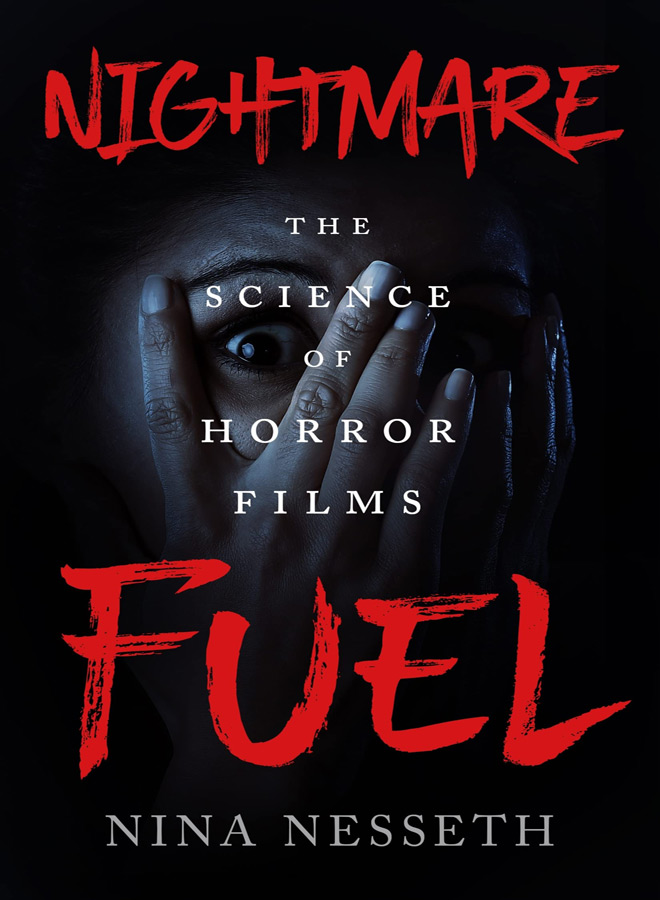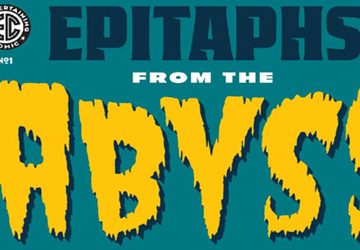Horror films have been a cinematic staple since near the creation of moving films themselves. People are drawn towards the thrill of a good scary movie, whether they involve monsters, killers, ghosts, and more. Some sub-genres have gotten louder, bloodier, and more shocking, while others have stayed quiet, eerie, yet more skin-crawling. How come? Why do people like Horror films?
Nightmare Fuel: The Science of Horror Films aims to answer those questions. Written by Nina Nesseth (The Science of Orphan Black, ECW Press, 2017), her book looks at Horror films from a psychological and physiological perspective. Nesseth explores 1973’s The Exorcist, 2018’s Hereditary, and every film in between and beyond to examine how and why they scare. What makes some spooky scares linger in the brains, and others fade as soon as they pass. The book was published by Tor Nightfire and released on July 26, 2022…but is it as in-depth as it seems?
It certainly comes off as quite scholarly. There are 8 main chapters buffered by an introduction and afterword, and each chapter tackles a different aspect of the Horror genre. Monsters in ‘How to Make a Monster’, lingering creeps in ‘Why Some Scares Stick with You’, the power of audio in ‘Putting Fear in Your Ears’, etc. Plus, a list of films and books Nesseth delved into for research at the very end, which is quite extensive (who remembers 1903’s Faust et Méphistophélès?).
However, her writing isn’t as dry as the scientific approach sounds. It brings up some interesting topics and breathes new life into familiar chestnuts like the ‘Uncanny Valley’- Professor Masahiro Mori’s idea that humans are particularly creeped out by figures that are too human to be fake, yet too fake to be human. Nesseth builds up on that by bringing up a 2008 study on the exact feelings the ‘Uncanny Valley’ produces and providing a tweaked graph that shows where famous movie monsters fall on it (zombies, haunted dolls, serial killers, etc.).
The book is also broken up with side-tangents as little breaks from the action. Namely interviews with author and Faculty of Horror co-host Alexandra West, film editor Jamie Kirkpatrick (My Friend Dahmer 2017, We Summon the Darkness 2019), and John Fawcett (Ginger Snaps 2000, Orphan Black 2013). They are quite interesting, though the ‘Scare Spotlights’ are perhaps more what readers are after. These are what they sound like- little segments that delve into particularly scary aspects of a famous film that relate to the chapter. E.g., ‘Blood, Gore, and Body Horror’ puts a spotlight on 1975’s Deep Red and why its brand of artificial blood won awards in the Seventies.
In general, Nesseth’s writing is relatable and understandable, in that it feels less like a lecture with an academic and more like one with a keen horror fan. For every study, researcher, and theory brought up, there are also points Horror fans would be all too familiar with. Like Horror trailers like spoil too much of the film (e.g., the 2018 Suspiria remake), and what experiences Horror fans go through (e.g., some prefer to watch them with friends, others only prefer ghosts and supernatural spooks to killers and gore, etc.).
It makes the more scientific concepts more digestible, like the responses Horror films evoke in its viewers (freeze, fight, flight, etc.), and why films love jump scares more than their audiences. The book also brings up problems with the scientific approach, like the majority of studies focusing largely on its white, heterosexual subjects than anyone else. Some may wrinkle at this comment, yet that does not mean it is not an issue, and Nesseth presents it in a calm and concise manner that few would find fault with.
Overall, Nightmare Fuel is a fine book that examines the science of Horror and Horror films with joy. It is a fascinating read, with enough personality to keep it from being dull and dreary. The book delves deep into its subject matter in all its forms and brings up plenty of interesting points about the Horror genre and the human mind. Some Horror fans might prefer to leave the proverbial frog undissected, but if they want to learn the ins and outs of why horror is scary, Nightmare Fuel is a great place to start. Thus, for these reasons, Cryptic Rock gives this book 4 out of 5 stars.






No comment